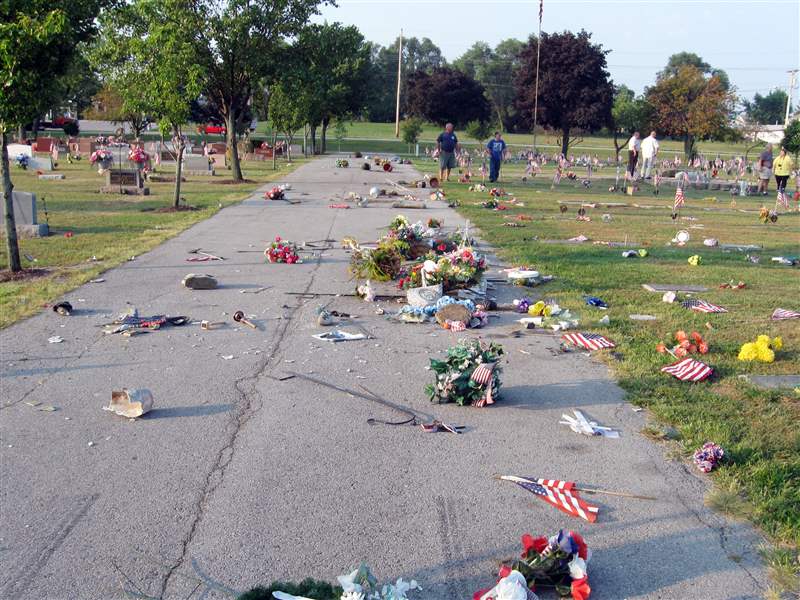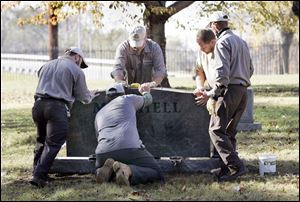
Vandalism takes toll on area cemeteries
11/14/2010
Police used DNA evidence to prosecute two teenage boys after 175 gravestones were knocked over and many others were damaged in September at McPherson Cemetery in Clyde, Ohio.
One week has passed since 25 damaged headstones at Calvary Cemetery in Toledo were repaired and returned to their rightful places, but no arrests have been made in the vandalism case.
And this resting place wasn't the first in the area to become the target of damage.
Cemeteries are vulnerable, often with little more than a fence between burial grounds and would-be vandals. Video surveillance systems and security personnel to guard the sites are expensive, and most cemeteries are unlit after dark.
Recently, additional instances of cemetery vandalism have occurred, including last month when 13 grave sites were damaged at Oak Grove Cemetery in Bowling Green by vandals who toppled tombstones and shattered urns.
In September, nearly 200 memorial stones were overturned at McPherson Cemetery in Clyde, the burial place of a Civil War general.
And at least 50 grave markers were toppled in March, 2009, at Historic Woodlawn Cemetery, where many of Toledo's most prominent leaders are buried.
Some historical and genealogical experts worry that destructive vandalism to cemeteries carries consequences worse than cracked headstones, and vandals probably have no idea they are eroding history preserved in stone.

Bob Sobiniak, left, Tim Evans, Roger Wilhelm, Bryan Lorann, and Terry Rankin install a headstone at Toledo's Historic Woodlawn Cemetery. At least 50 markers were toppled there in March, 2009.
“I think it's just kids. Unfortunately kids get in and there is a certain excitement to being in a cemetery when it's dark,” said Robert Harden, executive director and chief executive officer of Historic Woodlawn. “It's kind of creepy, ghosts and goblins and that kind of stuff. Unfortunately it gets kind of out of hand.”
Vandalism not only threatens “the specialness and the honor that's reflected in burying grounds,” said Barbara Powers, but also the information recorded on their stone monuments.
“It's a loss of a historical record, damage to the historical record, to the information cemeteries contain and convey about a person's life,” said Ms. Powers, head of inventory and registration at the Ohio Historic Preservation Office of the Ohio Historical Society.
Ohio has a special place in the emergence of the modern cemetery landscape as a “contemplative, serene type setting,” Ms. Powers said.
The first cemetery to model burial grounds after a lush park was built in Boston, and not long after in 1855 came Spring Grove Cemetery in Cincinnati, using the same principles of rural open space and floral landscape. Until then, the dead were typically buried in church yards, which quickly became overcrowded, according to Rest in Peace: A History of American Cemeteries by Meg Greene.
Now, the southern Ohio site and Historic Woodlawn in Toledo are the only two cemeteries in Ohio to be listed on the National Register of Historic Places.
Elusive culprits
At Historic Woodlawn, little evidence of vandalism remains nearly two years after 50 stones fell. To a degree, such vandalism is expected by cemetery staff, grounds foreman Terry Rankin said last week as he worked to install new granite markers and level uneven ground near the oldest parts of the cemetery.
“I figure we get it every couple years. Got us good last time,” Mr. Rankin said. “Just teenagers when they want to play.”
Law enforcement officials know that catching cemetery vandals can be tricky, and preventing the act is even harder.
Acts of cemetery vandalism happen rarely in the Toledo area, about once or twice a year, and often remain unsolved because of a lack of evidence. Video surveillance could change that, Toledo Police Chief Mike Navarre said.
“I'm a firm believer in technology,” Chief Navarre said. “If they can invest in some good surveillance cameras, we may not be able to prevent the offense from happening, but we can certainly go back and look at the video and identify who is doing it.”
If the offenders are caught, Toledo police said, the vandalism at Calvary Cemetery would likely be prosecuted as a fifth-degree felony. That is the lowest felony, which is punishable by up to 12 months in prison and a fine of up to $2,500, according to John Weglian, chief of the special units division for the Lucas County Prosecutor's Office.
The degree of felony could be increased, depending on the dollar amount of damage caused, police said, adding that the time usually must be served at a state prison. The most recent strengthening of the law occurred in 1998, Mr. Weglian said.
Though there are video cameras at the entrance and maintenance garage at Historic Woodlawn, installing cameras to cover the cemetery's 160 acres would be financially impossible, said Mr. Harden, head of Historic Woodlawn.
Security measures
Installing lighting also would be cost-prohibitive because the cemetery — which Mr. Harden calls “a walking tour of Toledo” or “outdoor museum” because of the dozens of civic leaders and local figures buried here — is about 135 years old and lacks electricity.
The best security at Historic Woodlawn is a pair of eyes. The grounds superintendent lives in a house on site and surveys the site before the gates are locked at dark and before he opens them come morning, Mr. Harden said.
“We try to keep the grounds as secure as we possibly can, and at the same time encourage people to walk and ride their bike and take advantage of the fact that we are a very beautiful park,” Mr. Harden said. “It's more of an arboretum than just a cemetery.”
At Calvary Cemetery, new fencing was installed after several graves were damaged in September. The new 7-foot-tall wooden fencing along Evansdale Avenue adjacent to older chainlink fencing behind St. Francis de Sales High School didn't stop vandals from pushing over about two dozen grave stones early Sunday.
“You just get sickened by it,” said Sally Oberski, director of communications for the Catholic Diocese of Toledo, which oversees the cemetery.
“There is a sense that someone's gotten away with this more than once or twice, they're going to start talking to their friends about it.”
The Toledo Catholic Diocese pays private security to monitor the area after dark.
Often, private security isn't enough to prevent graveyard vandalism, Clyde Chief Bruce Gower said, because “if you want to hide there is no way we're going to see you.”

Police used DNA evidence to prosecute two teenage boys after 175 gravestones were knocked over and many others were damaged in September at McPherson Cemetery in Clyde, Ohio.
The Clyde case
In September, vandals knocked over 175 grave markers and damaged many at McPherson Cemetery, named for Civil War Gen. James B. McPherson. A bronze statue of the Clyde native — the highest-ranking officer killed in the Civil War — stands at the entrance of the cemetery.
The city used DNA evidence to prosecute two teenage boys for the crime, and they expect further testing to implicate a third, Chief Gower said.
“We asked the kids why they did it, and they didn't really have an answer,” Chief Gower said. “They really just thought it'd be fun, I guess. I really can see no reason to do it, but they did.”
Though the case is among the worst cemetery vandalism in recent memory, the city hasn't changed much to secure the cemetery.
The gated grounds remain unlocked to allow easy access to police investigating suspicious activity, which is reported more often by watchful neighbors of the cemetery, Chief Gower said.
“It's something we don't want to overreact to, because we could spend a lot of money and put in cameras and lights. I've been here 32 years and [it had] never happened, and it might never happen for another 32 years,” Chief Gower said. “Neighbors out there are a lot more vigilant now.”
A matter of respect
Vicki Blum Vigil, an author and retired school counselor from Euclid, a suburb of Cleveland, has been dismayed over cemetery vandalism since becoming fascinated by graveyards WHEN reading newspaper obituaries became habit.
After reading that the headstone of a Fostoria woman read, “Gone to Wal-mart,” she was hooked.
“It got me thinking what else is on people's headstones,” she said.
The fascination inspired at least two of her books, Cemeteries of Northeast Ohio and Cleveland Cemeteries: Stones, Symbols and Stories, among several other local history books.
She is president of the Ohio Cemetery Alliance and chairman of the cemetery committee for the Ohio Genealogical Society and recently co-led a project in cooperation with the city of Cleveland and Church of Jesus Christ of Latter-day Saints to catalog the 363,000 death records kept at city cemeteries. It took about 60 volunteers three years to finish.
She said vandals probably don't understand the historical value of the grave markers they are destroying. Cemetery records that accompany headstones can offer valuable information related to genealogy and public health, Ms. Vigil said.
“It bothers me because it's so useless. They're getting nothing from it. You're not getting fame, fortune. You're not getting a beer to drink,” Ms. Vigil said.
Perhaps acts of vandalism could be prevented if children are taught the value of cemeteries, she said.
“I also think that if you take young people there, 10 years old or whatever, they get a different feeling for the past, for what matters. It's not scary to them,” Ms. Vigil said. “It sticks with you if see it, you touch it, you had to climb a hill to find it.”
Contact Bridget Tharp at: btharp@theblade.com or 419-724-6086.